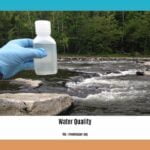Waterdrop RO systems are making waves with their sleek, tankless designs and smart features, but are they truly as good as they seem? This comprehensive review dives into the performance, value, and potential drawbacks of Waterdrop’s most popular RO systems, helping you determine if they’re the right fit for your home and health.
Waterdrop: A New Wave in Water Filtration
Waterdrop is a rapidly growing brand in the home water filtration market, known for its innovative tankless reverse osmosis (RO) systems and focus on cutting-edge technology. They offer a range of models to suit various needs and budgets, from the budget-friendly G3 Series to the feature-packed X Series and the user-friendly A1 countertop system.
But with so many RO systems vying for your attention, it’s crucial to cut through the marketing hype and understand what Waterdrop brings to the table. This review will equip you with the knowledge you need to make an informed decision about whether a Waterdrop RO system is the right choice for you.
Waterdrop G3 Series: Striking a Balance Between Performance and Value
The Waterdrop G3 Series is a popular choice for homeowners seeking an effective and space-saving RO system without breaking the bank. Let’s take a closer look at what makes this series stand out.
Performance: Putting Contaminant Removal to the Test
Independent testing from reputable sources like WaterFilterGuru.com indicates that the G3 P800, a flagship model in the G3 Series, excels at removing a wide range of contaminants, including:
- Lead: This heavy metal poses significant health risks, especially for children. The G3 P800 effectively removes lead to levels well below the EPA’s maximum contaminant level (MCL).
- Fluoride: While beneficial in small amounts, excessive fluoride can be detrimental to health. The G3 P800 significantly reduces fluoride concentrations, providing peace of mind for those concerned about overexposure.
- Arsenic: This naturally occurring element can contaminate groundwater and poses serious health risks. The G3 P800 consistently removes arsenic to levels meeting stringent safety standards.
https://www.lolaapp.com/best-ro-system-for-well-water-with-arsenic/
Design: Embracing the Tankless Advantage
The G3 Series, like all Waterdrop RO systems, embraces a tankless design. This innovative approach offers several benefits:
- Space-Saving: Eliminating the bulky storage tank found in traditional RO systems frees up valuable under-sink space.
- Freshness: Water is filtered on demand, ensuring you always enjoy a fresh, pure glass of water.
- Reduced Water Waste: Tankless systems minimize water waste associated with the flushing of stagnant water in traditional systems.
However, it’s essential to acknowledge potential limitations of tankless designs:
- Flow Rate: Tankless systems might have slightly lower flow rates compared to their tanked counterparts, especially during peak usage times.
- Initial Cost: Tankless RO systems generally have a higher upfront cost than traditional models, but this can be offset by long-term savings on water bills and filter replacements.
Features: Balancing Functionality and Affordability
The G3 Series prioritizes essential features while maintaining an attractive price point. Here’s what you can expect:
- NSF/ANSI Certifications: The G3 P800 and other models in the series have earned prestigious certifications from NSF International, an independent organization that tests and certifies water treatment products. These certifications provide assurance that the system meets rigorous safety and performance standards.
- Multi-Stage Filtration: The G3 Series typically employs a multi-stage filtration process, including a sediment pre-filter, carbon block filters, the RO membrane, and a final polishing filter. This comprehensive approach ensures the removal of a wide spectrum of contaminants, improving both the taste and safety of your water.
https://www.lolaapp.com/do-water-filters-remove-chlorine/
It’s worth noting that the G3 Series does not include a built-in remineralization filter, which is a feature found on some higher-end RO systems.
What is Remineralization, and Why Does it Matter?
Remineralization is the process of adding beneficial minerals back into water that has been stripped of its natural mineral content during the RO purification process.
Pros of Remineralization:
- Enhanced Taste: Minerals like calcium and magnesium contribute to the pleasant, slightly sweet taste of mineral water.
- Potential Health Benefits: Some studies suggest that drinking mineral-rich water may have health benefits, such as supporting bone health and regulating blood pressure. However, more research is needed to confirm these benefits conclusively.
Cons of Remineralization:
- Added Cost: RO systems with built-in remineralization filters typically come with a higher price tag.
- Maintenance: Remineralization filters require periodic replacement, adding to the overall maintenance costs.
Whether or not remineralization is essential for you depends on your individual health needs and preferences. If you’re concerned about mineral depletion, you can always purchase a separate remineralization filter to add to your Waterdrop RO system.
https://www.lolaapp.com/best-water-softener-system-for-well-water/
Value: Assessing Affordability and Long-Term Costs
The Waterdrop G3 Series offers excellent value for homeowners seeking a reliable and efficient RO system without breaking the bank. While the initial investment might be slightly higher than some budget-friendly RO systems on the market, the G3 Series’ tankless design and long-lasting filters can lead to long-term cost savings.
Factors contributing to the G3 Series’ value proposition include:
- Competitive Pricing: Waterdrop generally positions its products at competitive price points within the RO system market.
- Long Filter Lifespan: Depending on usage and water quality, the filters in the G3 Series can last for several months before needing replacement.
- Water Efficiency: The tankless design minimizes water waste, potentially leading to lower water bills over time.
Waterdrop X Series: Innovation and Convenience at a Premium
For those seeking the latest in water filtration technology and unparalleled convenience, the Waterdrop X Series stands as a compelling option.
Features: Elevating the User Experience
The X Series sets itself apart with a range of high-tech features designed to simplify and enhance the user experience:
- Ultra-Fast Filtration: The X Series boasts significantly faster filtration speeds compared to traditional RO systems, delivering purified water with minimal wait time.
- Smart Faucet Integration: Some models within the X Series integrate seamlessly with smart faucets, providing real-time information about water quality, filter life, and more.
- App Connectivity: Embrace next-level convenience with app connectivity, allowing you to monitor your RO system’s performance, track water consumption, and receive filter replacement reminders directly from your smartphone.
Performance: Meeting High Expectations
While specific performance data for the X Series might vary depending on the model, it’s reasonable to expect top-tier filtration efficiency based on the advanced technology employed.
Key Performance Indicators to Consider:
- Contaminant Rejection Rate: Look for systems with a high contaminant rejection rate, indicating their effectiveness in removing impurities.
- Water Flow Rate: Consider the system’s flow rate, especially if you have a large household or frequently use filtered water for cooking and other tasks.
- Noise Level: Tankless RO systems generally operate quietly, but it’s still essential to consider noise levels if noise sensitivity is a concern.
Value: Justifying the Premium Price
The X Series undoubtedly comes at a premium price point compared to the more budget-friendly G3 Series. However, the advanced features, convenience, and potential long-term benefits might justify the investment for some homeowners.
When assessing the value of the X Series, consider these factors:
- Your Budget and Priorities: Determine if the premium features and convenience justify the higher price tag based on your household’s needs and financial situation.
- Long-Term Cost Savings: While the initial investment is higher, the X Series’ fast filtration speeds and potential water savings could offset some costs.
- Tech Integration: If you value smart home technology and seamless integration, the X Series’ smart features might be a significant selling point.
Waterdrop A1: The User-Friendly Countertop Option
Not everyone needs or has the under-sink space for a traditional RO system. The Waterdrop A1 countertop RO system provides a convenient and flexible alternative, offering powerful filtration in a compact and user-friendly package.
Target Audience: Ideal for Smaller Spaces and Renters
The A1 is particularly well-suited for:
- Apartments and Smaller Kitchens: Its countertop design eliminates the need for under-sink installation, making it a great choice for smaller living spaces.
- Renters: The A1’s portability allows for easy relocation, making it an excellent option for renters who want to take their filtered water with them.
- Those Seeking Simplicity: The A1’s user-friendly design and straightforward operation make it an excellent choice for users who prefer a hassle-free experience.
Features: Prioritizing Ease of Use
Key features of the Waterdrop A1 include:
- Intuitive Display: The A1 features a clear and easy-to-read display that provides information about water quality, filter life, and system status.
- Simple Filter Replacement: Changing the filters in the A1 is designed to be quick and easy, minimizing downtime and hassle.
- Sleek and Compact Design: The A1’s modern and compact design complements a variety of kitchen aesthetics without taking up valuable counter space.
Performance: Balancing Convenience and Efficiency
While the A1’s compact size might suggest limited filtration capabilities, it still employs a multi-stage filtration process, including an RO membrane, to effectively remove a wide range of impurities.
Factors to Consider:
- Filtration Speed: Countertop RO systems generally have a slower filtration speed compared to their under-sink counterparts.
- Water Tank Capacity: The A1 likely has a smaller water tank capacity than under-sink systems, which might require more frequent refills.
Value: Assessing Convenience and Portability
The Waterdrop A1 strikes a balance between convenience, performance, and affordability. While it might not be the most feature-rich or fastest RO system on the market, its user-friendly design, portability, and effective filtration make it an excellent choice for those seeking a simple and convenient solution for accessing purified water.
Is a Waterdrop RO System Right for You?
Waterdrop has quickly become a significant player in the home water filtration market, offering a range of RO systems designed to appeal to a wide range of consumers.
Here’s a recap of the key pros and cons to help you decide if a Waterdrop RO system is the right choice for you:
Pros:
- Tankless Design: Waterdrop’s commitment to tankless technology frees up valuable space and provides on-demand access to fresh, filtered water.
- Innovative Features: From smart faucet integration to app connectivity, Waterdrop incorporates cutting-edge technology to enhance the user experience.
- Variety of Models: Whether you’re on a budget, seeking premium features, or prefer a countertop solution, Waterdrop offers a model to suit your needs.
- Competitive Pricing: Waterdrop generally offers its RO systems at competitive price points, making them accessible to a wider range of consumers.
Cons:
- Lack of Built-in Remineralization: Most Waterdrop RO systems lack built-in remineralization filters, which might be a concern for those seeking to add minerals back into their purified water.
- Potential Flow Rate Limitations: As with all tankless RO systems, Waterdrop’s systems might experience slightly lower flow rates compared to traditional tanked models, especially during peak usage times.
- Transparency Regarding Manufacturing: While not a dealbreaker for all consumers, Waterdrop could improve its transparency regarding its manufacturing processes and global supply chain.
Ultimately, the best RO system is the one that best meets your individual needs and preferences. By carefully considering the factors outlined in this review, you can make an informed decision about whether a Waterdrop RO system is the right choice for your home and lifestyle.
Why Can’t You Drink Reverse Osmosis Water?
Reverse osmosis (RO) systems are lauded for their ability to filter out impurities, making them a popular choice for those seeking the purest water possible. But what if this pursuit of purity comes at a cost? This section delves into the potential downsides of drinking reverse osmosis water, separating fact from fiction and empowering you to make informed decisions about your water consumption.
The Double-Edged Sword of Purity: Understanding Mineral Depletion
The very process that makes RO systems so effective at removing contaminants can also strip water of its beneficial minerals. Let’s break it down:
- How RO Works: RO systems utilize a semi-permeable membrane with incredibly small pores. This membrane acts as a fine sieve, allowing water molecules to pass through while blocking larger particles like bacteria, viruses, heavy metals, and even salts dissolved in the water.
- The Unintended Consequence: While highly effective at removing impurities, this filtration process can also remove beneficial minerals naturally found in water, including:
- Calcium: Essential for strong bones and teeth, muscle function, and nerve transmission.
- Magnesium: Plays a vital role in over 300 bodily functions, including muscle and nerve function, blood sugar control, and blood pressure regulation.
- Potassium: Crucial for maintaining fluid balance, regulating blood pressure, and supporting muscle and nerve function.
- Sodium: While often demonized, sodium is an essential mineral involved in fluid balance, muscle contraction, and nerve function.
- The Claim of Harm: Some sources claim that drinking RO water causes more harm than the contaminants found in tap water due to this mineral depletion. While further research is needed to substantiate this claim definitively, it underscores the importance of understanding the potential consequences of long-term consumption of mineral-deficient water.
Potential Health Impacts of Demineralized Water: Separating Fact from Fiction
The potential health impacts of drinking demineralized water, like that produced by some RO systems, are a subject of ongoing research and debate. Here’s what we know so far:
- Electrolyte Imbalance: Electrolytes, minerals with an electrical charge, are crucial for maintaining numerous bodily functions. Drinking demineralized water can disrupt the delicate electrolyte balance in our bodies, potentially leading to:
- Fatigue and Weakness
- Muscle Cramps
- Nausea and Vomiting
- Dizziness and Lightheadedness
- In severe cases, electrolyte imbalances can lead to irregular heart rhythms and seizures. However, it’s important to note that these severe consequences are usually associated with extreme dehydration or underlying medical conditions.
- Mineral Deficiencies: While a balanced diet should provide most of the minerals our bodies need, drinking mineral-rich water can contribute to our daily intake. Long-term consumption of RO water, especially if dietary intake of these minerals is low, could contribute to mineral deficiencies.
- The “Aggressive” Water Theory: Some proponents of mineral-rich water propose that demineralized water, in an attempt to regain its natural mineral balance, can leach minerals from the body. This theory, while intriguing, lacks robust scientific evidence and requires further research to confirm or refute.
It’s crucial to emphasize that the severity of these potential health risks depends on various factors:
- Mineral Content of Your Diet: If you consume a mineral-rich diet, the impact of drinking demineralized water might be minimal. However, if your diet is lacking in essential minerals, the effects could be more pronounced.
- Overall Health Status: Individuals with pre-existing health conditions or specific mineral deficiencies might be more susceptible to adverse effects from drinking demineralized water.
- Duration and Quantity Consumed: The potential health risks are likely associated with long-term and high-volume consumption of demineralized water.
The Importance of a Balanced Perspective: Not All RO Systems Are Created Equal
It’s essential to remember that not all RO systems are created equal. While some systems might produce highly demineralized water, others incorporate features to mitigate these concerns:
- Remineralization Stages: Some RO systems include built-in remineralization stages that add beneficial minerals back into the purified water. These systems aim to provide the purity of RO filtration while restoring a healthy mineral balance.
- Water Quality Considerations: The decision of whether or not to use an RO system, and which type to choose, depends largely on the quality of your local tap water. If your tap water is heavily contaminated, the benefits of removing those contaminants might outweigh the risks of moderate mineral depletion.
Making Informed Choices About Your Water: Tips for RO System Owners
If you own an RO system or are considering purchasing one, here are some tips for ensuring you’re consuming safe and healthy water:
- Know Your Water: Get your water tested to understand its mineral content. This information can help you make informed decisions about whether you need a system with a remineralization stage or if you need to supplement your diet with minerals.
- Choose Wisely: If mineral depletion is a concern, opt for an RO system with a built-in remineralization stage.
- Talk to Your Doctor: Consult with your doctor about your individual water needs, especially if you have pre-existing health conditions or dietary restrictions.
- Don’t Overlook Diet: Remember that your primary source of essential minerals should be a balanced and nutritious diet.
https://www.lolaapp.com/how-long-does-a-water-filter-last/
Is Waterdrop Filter a Chinese Company? Unveiling the Origins & Manufacturing
Waterdrop, a rapidly growing name in the water filtration industry, has garnered attention for its sleek designs and innovative technology. But where does Waterdrop come from, and are its products manufactured in China? This section explores the origins of Waterdrop, addressing consumer concerns about transparency and manufacturing practices.
Tracing the Roots: Waterdrop’s Global Presence
Waterdrop maintains a global presence, making it tricky to pinpoint its origins definitively. While their official “About Us” page might not explicitly state their founding location, research suggests a strong connection to China.
- Manufacturing Hub: Multiple sources, including industry experts and product reviews, confirm that Waterdrop’s manufacturing primarily takes place in China. It’s crucial to understand that China serves as a global manufacturing hub for countless international brands across various industries. This fact alone doesn’t necessarily reflect negatively on a company’s quality or ethics.
- Global Sourcing: Waterdrop’s website mentions “global sourcing,” indicating that they might source components and materials from various countries, potentially including the US. However, specific details about the origin of individual components are often lacking.
Quality Control and Standards: Going Beyond the “Made in China” Label
The perception of “Made in China” products varies widely. While some consumers associate it with lower quality, others recognize China’s capacity for high-quality manufacturing. When evaluating Waterdrop, it’s crucial to look beyond the country of origin and focus on these key factors:
- Compliance with Regulations: Waterdrop filters sold in the US must meet strict safety and quality standards, including those set by the Safe Drinking Water Act (SDWA). This compliance suggests that Waterdrop adheres to essential regulations within the countries where its products are sold.
- Certifications and Independent Testing: Look for certifications from reputable third-party organizations like NSF International and the Water Quality Association (WQA). These certifications indicate that Waterdrop’s products have undergone rigorous testing and meet specific performance standards.
- Transparency and Communication: Waterdrop could enhance its transparency by providing clearer information about its manufacturing locations, quality control processes, and sourcing practices. Greater transparency fosters trust and allows consumers to make more informed choices.
Consumer Empowerment: Prioritizing Transparency and Informed Choices
As consumers, we have the power to demand greater transparency from companies like Waterdrop. Here’s how we can encourage positive change:
- Demand Information: Reach out to Waterdrop directly through their website, social media channels, or customer service lines to inquire about their manufacturing locations, sourcing practices, and commitment to ethical labor practices.
- Support Transparency: When making purchasing decisions, prioritize companies that openly share information about their supply chains and manufacturing processes.
- Share Your Values: Let companies know that transparency and ethical sourcing are important to you as a consumer. Your voice can make a difference.
Beyond the Origin: Evaluating Waterdrop on its Merits
While the origin of a product is a valid consideration, it’s crucial to evaluate Waterdrop based on a comprehensive set of criteria:
- Filtration Technology: Waterdrop utilizes advanced filtration technologies, including reverse osmosis, to effectively remove a wide range of contaminants from water.
- Product Design and Features: Waterdrop receives consistently positive feedback for its sleek designs, user-friendly interfaces, and innovative features like tankless systems and smart faucet integration.
- Price-to-Value Ratio: Waterdrop’s products are often praised for their competitive pricing and value for money, particularly compared to some established brands in the water filtration market.
- Customer Reviews and Satisfaction: Online reviews from Waterdrop customers are generally positive, highlighting the ease of use, effectiveness, and customer support.
- Environmental Impact: Waterdrop’s tankless RO systems align with sustainability goals by minimizing water waste compared to traditional tanked systems.
By considering these factors in conjunction with your values regarding transparency and ethical sourcing, you can make a well-informed decision about whether Waterdrop aligns with your needs and preferences as a consumer.
- Crypto Quotes’ Red Flags: Avoid Costly Mistakes - June 30, 2025
- Unlock Inspirational Crypto Quotes: Future Predictions - June 30, 2025
- Famous Bitcoin Quotes: A Deep Dive into Crypto’s History - June 30, 2025















